`HORSES` BY MIMA ROBERTSON, born 1901
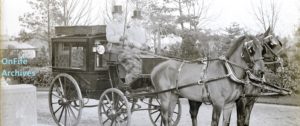
Looking back on my childhood it seems that horses and ponies played an important part in it. John Goodall had a large livery-stable, which provided cabs for the station – luggage on the roof – carriages or landaus for special, with sometimes two horses, gigs and pony-carts, hearses with handsome black horses decked out with black plumes. Father used to hire a Shetland pony for me to ride when I was about five but that did not last long as Mother was afraid I would fall off and injure myself. (Later I got a bicycle on which I performed far more hazardous feats – tramlines made cycling dangerous as it was easy to catch ones front-wheel in one when speeding down the steep Townhill Road).
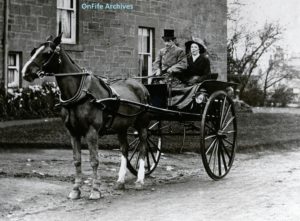
But my great delight was when Father summoned a `trap` from Goodall`s, perhaps in a late summer afternoon when he had returned from the office. This was a lightweight vehicle with two high wheels and a seat for two perched up behind the dashboard and usually a mettlesome animal between the shafts. With a rug round my black-stockinged legs and my feet not touching the floor I would sit by Father`s side while he, expertly handling the reins and the slender whip, would take us out into the country, down to Limekilns perhaps and round by Saline. Then, as there was very little traffic on the roads, I was allowed to experience the thrill of driving the horses myself, learning to hold the reins properly as we went along at a smart pace that only slackened when climbing a hill. That was a real treat and I`m sure Father enjoyed it as much as I did.
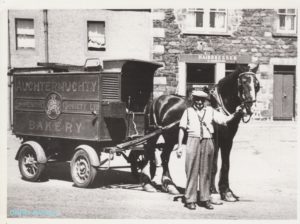
Then there were the tradesmen`s horses, tramping down the avenue to the yard where they took sugar from me while the baker – Allans, with a very smart van high-sided with gold lettering on red paint – or the butcher or the grocer had a chat with the housemaid at the back door. Our Doctor Fleming who had a small brougham in winter, an open Victoria in summer, also made frequent calls. His coachman, Peter McArthur, was a firm friend of mine and he sometimes took me off for a turn round the Park while the doctor was taking Mother`s pulse. He was never in a hurry and never complained when we kept him waiting. Changed days indeed!
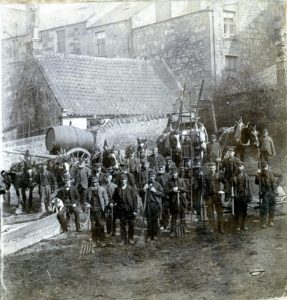
Dunfermline Cleaning gang with horses
Ashes and house-refuse were collected by another horse-drawn vehicle belonging to the town corporation from the stone-built rubbish-container at the top of the garden between the greenhouse and the wash-house. I met other horses on my way through the town and often stopped for a chat as they stood patiently by the pavement. There were always two or three horse-drawn cabs waiting at the Lower Station – in those days Dunfermline was an important railway-junction and one could take trains to Edinburgh, Perth, Stirling, Alloa, St. Andrews, etc. at frequent intervals. The bus that went to Limekilns and Charlestown was horse-drawn and for some years after the `14 War could be found waiting at the Glen gates near the Abbey.
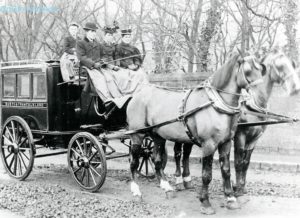
When I was about eleven Mother and I stayed one summer holiday at the Athol Palace, Pitlochry, and went on a wagonette to Braemar. There were four horses, passengers inside and out, and when we reached the Devil`s Elbow everyone except the driver had to walk up – and later down – the steep curves of the road. I was on the box beside the driver – trust me! – and was allowed the honour of holding the reins for a short spell. Driving four horses, spanking along – I have never forgotten it.
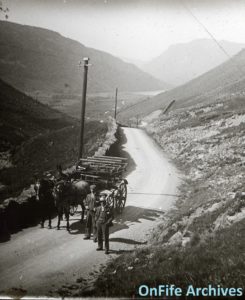
Thanks to Cupar Local Studies for the majority of the photographs.
NOTE ON MIMA ROBERTSON
Mima Robertson was born in 1901 to John Whyte Robertson and his wife Jemima Taylor and was baptised Jemima Simpson Taylor Robertson. Her father worked for the family firm of Hay and Robertson, linen and cotton manufacturers, and her mother was the daughter of John Taylor a West Indian merchant. The couple already had two children, Margaretta born in 1889 and William born in 1893. In 1891 the family lived
at Dunsloy Villas, New Row, in 1901 at 3 Comely Park Place, and from about 1906 at Witchbrae, Townill Road. Witchbrae had been built in about 1860 for the Hay family and was advertised for sale in 1926 as a `fine dwelling house` set in two acres of grounds with excellent views to the south. It was lit by electricity, had several public rooms, six bedrooms, bathrooms, two bedrooms and a bathroom for the maids and numerous utility rooms and outbuildings. The Robertsons kept at least three female servants as well as the outdoor staff.
After an early education at Roseberry House, a private school in the Masonic Lodge, New Row, Miss Robertson was sent to boarding-school. She was so unhappy there that she was brought home to be educated by a governess. The governess, apparently an inspiring teacher, had taught classics at a boys` school and now she taught Latin to Mima, who found it stood her in good stead in her writing.
Mima had written stories from early childhood and when she was 19 received her first payment, 20 shillings from Punch for a humorous article. She loved to travel especially to Brittany and in 1926 she had a story called A Change of Air, set between Brittany and Dunfermline, accepted by a London agent and publishers, who changed the title to The Leopard`s Skin. Other novels with a Dunfermline connection were The Sport of Circumstance and Bitter Bread , while After Stormy Seas was again based in Brittany and Music in the Air in Gottland, the Baltic island, also a holiday destination.
Then followed two historical novels under the name `Alison Taylor`, Alison because it was Scottish and Mima liked it better than her own, and Taylor, her mother`s maiden name. For a change, Evil Enchantment of 1930 was a psychological thriller which she felt would have made a good film.
In the early 1930s when her writing had become a real necessity Miss Robertson was invited to contribute serials to the magazines run by Leng Publications of Dundee, particularly the People`s Friend. She was associated with the People`s Friend for some 40 years and found that writing to order involved a strict routine unlike the free-and-easy hours she had been used to. She continued to write novels and in 1953 published The Castilian, a historical novel about William Kirkcaldy of Grange, who was executed for his attempt to hold the besieged Edinburgh Castle for Mary Queen of Scots.
Mima Robertson had talents other than writing. She played first violin in Dunfermline Amateur Orchestra and was an artist and a needlewoman. She captained the Dunfermline Tennis Club ladies and became President of the Dunfermline Soroptimists. Miss Robertson never married and during the depression of the 1930s, when the family fortunes plummeted, the income from her writing became even more important. From Witchbrae, Mima and her parents moved to 9 Cameron Street where her mother died in 1944 and her father in 1959. Miss Robertson then moved to a flat at 15 Cameron Street and it was here in 1979 that she wrote her magnum opus Old Dunfermline and where she died in 1985 aged 83.
In Miss Robertson`s article on horses, the house referred to is Witchbrae and one of the six bedrooms probably became the schoolroom and what Miss Robertson called `My Room`. `Neil` was the gardener Neil McLean, and `Miss Nimmo` possibly the `nurse and sewing maid for one girl 4½ years` that Mrs. Robertson advertised for in 1906. Or perhaps `Miss Nimmo` was the governess who did sewing as well. The sources for this biography come from various on-line genealogy and newspaper sites, from Dunfermline Press, March 13 1970 (largely reproduced in Hugh Walker`s The History of Hay and Robertson, 1995) and Miss Robertson`s papers, which include (possibly unpublished) stories and plays, and are currently being archived at Dunfermline Carnegie Library but are not yet catalogued.
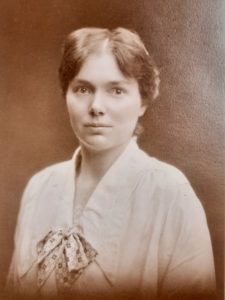
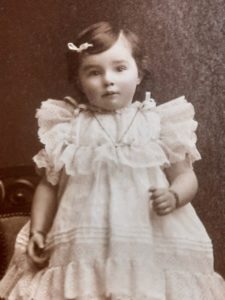
Suzie Marshall, wonderful volunteer with the local studies department in Dunfermline Carnegie Library and Galleries, has spent many hours researching the life and family history of two of Dunfermline’s former residents . Firstly we find out about…
Vonda Sturrock – missionary in the Congo
Vonda Melvill Sturrock was born in Dunfermline on 30th January 1902 the only child of Peter Sturrock Sturrock and Ada Edith Sturrock (nee Clark) who had met and married in Baghdad in 1900 where they were both working as misssionaries. The family lived at 25 Canmore Street, moving to 7 Comely Bank when Vonda was about 8.
Growing up she had a busy life, singing in choirs and playing the organ, learning Greek, studying the bible, helping her father dispense medicine and teaching at Sunday School. She studied Cello at the Carnegie Musical Institute from the age of 11
In July 1923 after breaking off an engagement, she felt called to follow in the family footsteps to become a missionary. She was accepted as a missionary candidate by the Africa Inland mission in August 1923 but had to spent two years of Faith Mission training to study the bible which she did at Livingstone College (1924-1926)
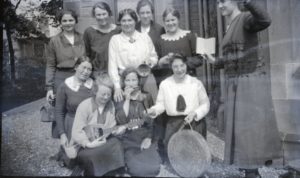
Following that she spent two years studying medicine (1926-1928) and also took a book-keeping course. Her training wasn’t finished as she was introduced to missionary work by being on “deputation” in Northern Ireland before finally, in March 1933 taking a diploma of Tropical Medicine in Belgium before sailing for the Congo in 1934
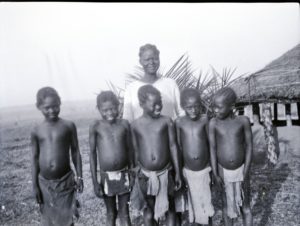
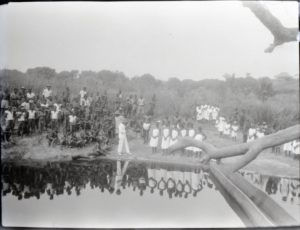
Vonda took a furlough from Missionary work in 1939 but didn’t return to the Congo, living in Edinburgh until her death in 1987.
Whilst looking into Vonda’s fascinating archive, Suzie found several other remarkable women in Vonda’s family tree, most notably her great aunt, but we can’t claim her in Fife.
Agnes Marshall Cowan
She was born 19/4/1880 and died 22/8/1940 Agnes was one of the first fully qualified female physicians in Britain and a medical missionary in Manchuria during the plague years. Her father was Sir John Cowan a business leader, wine merchant and a philanthropist. Educated at Edinburgh University where she graduated with an M.B. Ch.B in July 1906 she then became House Physician at Leith Hospital. Later, she was appointed House Surgeon Eye Dept. Royal Infirmary in Edinburgh.
By 1913, Agnes was working as a medical missionary in Manchuria at the time under Russian influence and experiencing political unrest. In March 1914, she was based at the hospital in Ashiho, near Harbin, in northern China. She later worked at the hospital in Mukden (modern day Shenyang) as a midwife. The hospitals were supported by the University of Edinburgh and the Church of Scotland and sponsored by charities in Scotland.
Agnes returned to Britain during WW1 and was appointed as assistant medical officer at HM Cordite Factory Gretna in April 1917. In May 1918 she served with the Royal Army Medical Corps and was attached as medical officer to Queen Mary’s Auxiliary Army Corps.
Following the end of the war in 1919 Agnes returned to Manchuria and was appointed to work again at the Woman’s Hospital in Mukden. She was also appointed a Member Royal College of Obstetricians and Gynaecologists. Her work in Manchuria included lecturing as a Professor of Obstetrics and Gynaecology at the Mukden Medical College against a background of political unrest in the region following the Japanese annexation of Manchuria in 1931. She finally returned to Scotland in 1939 suffering from ill health.
To find out more about Vonda and the archive of information left to Dunfermline Carnegie Library and Galleries contact us on localstudies.dunfermline@onfife.com. For the month of March DCLG has a display in the Reading Room showing more of Vonda’s story.
This is the second blog from our fantastic volunteer Suzie, in celebration of International Women’s Day
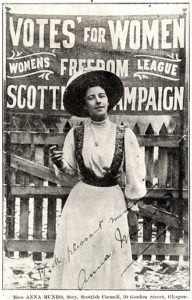
Anna Munro
Anna Gilles Macdonald Munro was born in Glasgow in 1881 and died in 1962 . Her father was a school master and the family lived in Edinburgh until 1892 when Anna’s mother died and then she and her sister, Eva, moved to Dunfermline to live with her paternal Aunt and her husband, Pastor Jacob Primmer.
Having worked for three years for The Sisterhood of the Poor Movement in the East End of London, Glasgow and Edinburgh, Anna was very moved by what she saw. A lifelong supporter of the Labour Party, she served as both chair and president of her local committee. Her fight for female franchise was compassionately rooted in helping women in poverty.
Anna joined the Women’s Social and Political Union (WSPU) in 1906 and became its organiser in Dunfermline. However the WSPU was becoming less democratic and there were concerns that its leadership under Emmeline and Christabel Pankhurst was becoming dictatorial. Anna and several members, including Charlotte Despard and Teresa Billington-Greig broke away and created the Woman’s Freedom League (WFL).
Teresa Billington-Greig was the first Suffragette sent to Holloway. Charlotte Despard was the first woman to refuse to pay taxes as a protest, an action which quickly inspired others to form the Women’s Tax Resistance League (these activities were expanded upon in Apr 1911 when the WFL passed a resolution to boycott the national census protesting against the omission of women’s suffrage for the Kings Speech sending copies of the resolution to Asquith and Churchill. Women householders either spoilt or failed to complete their census forms) In 1907 Anna became Teresa Billington Greig’s personal secretary.
The Women’s Freedom League grew rapidly, and soon had sixty branches throughout Britain with an overall membership of around 4,000 people. This was over twice the size of the WSPU. The WFL also established its own newspaper, “The Vote”
The WFL classed themselves as a militant organisation (over 100 of their members were sent to prison after being arrested on demonstrations or refusing to pay taxes), but unlike the WSPU they refused to attack people or property other than ballot papers. Their actions included protests in and around the House of Commons and other acts of passive civil disobedience such as payment of taxes; their principal being ‘no tax without representation’. WFL activities in 1908 included attempts to present petitions to the king and have deputations received by cabinet ministers while further protests were held in the House of Commons such as Suffragettes chaining themselves to the grille in the Ladies gallery.
In January 1908 Anna took part in a deputation to see Cabinet Minister Richard Haldane. The WFL had petitions protesting against the omission of Women’s Suffrage from the King’s Speech and asked him to use his vote to get the measure passed. When Haldane refused to come out to meet them Anna pinned a large “Votes for Women” flag on the door and told the crowd “OK we will wait for him” and addressed the crowd. The police attempted to move her on and suggested she “go and buy some chocolates” and Anna accused them of impudence, carried on addressing the crowd and was arrested. At her trial she stated “I have come from Scotland for this purpose. I lost my hat yesterday in the crowd, trying to present petition to the King.” On reporting the trial the Dundee Courier claimed her to be “an excellent and fluent speaker”. She was imprisoned in Holloway Prison for six weeks.
A letter in the Aberdeen Press & Journal 5th February 1908 from Pastor Jacob Primmer, Anna’s uncle, to the Home Secretary (Herbert Gladstone) :-
“The Manse, Kingseathill, Dunfermline, 31 Jan 1908
Dear Sir
As the uncle of Miss Anna Munro who at Westminster Court yesterday , got the cruel and vindictive punishment of six weeks imprisonment – while for the same political offence the sentence at Marylebone was 40 shilling or twenty-one days imprisonment and 40 shilling, or one month, as a Suffragist – allow me to point out that for long she has been in delicate and precarious health; that only four weeks ago she fell down in a faint in a Glasgow street; that imprisonment will be most serious in its consequence; that therefore you should order her liberation from prison, and that until that be done she should be kept in the infirmary.
On 8th February E Blackwell responded on behalf of the Secretary of State saying he could find no grounds for releasing her. However her uncle had already received a telegram (S7) saying that she was free after someone had paid surety of £20 (Dundee Courier 12th Feb 1908).
Jacob Primmer responded that his niece had been arrested for
“the awful crime of knocking up some of your fellow Cabinet Ministers at 9:30am and holding outside public meetings until they made their appearance. It was my niece who put the question to the Prime Minister in Dunfermline on 22nd October last –
‘As the Prime Minister believes in Women’s suffrage would he suggest some method we could adopt in order to get our enfranchisement soon? He said I think they ought to go on agitating and holding meetings and pestering people as much as they can, as all other men and women who are interested in public questions have to do.’
Is not, therefore, outrageous and the playing of the tyrant keep them in the common prison among the vilest the nation for following the advice of your superior—the head the Government? Remember that cruelty and intolerance never pay, even the part of a Home Secretary. Is it not farcical to charge a frail and weak young lady with resisting number of elephantine, six feet five inches policemen? And for this awful crime to suffer six weeks Holloway Prison? Doctors and others Dunfermline can bear testimony to the delicate and precarious health of my niece, yet you say that she ‘is fair general health’. This is emphatically contradicted in letter received from her this evening. She writes—‘you know, I came out of Holloway last night after being in ten days. It was either case of that or hospital!’ And she complains suffering from a frightful headache. It would be well if in future you got some honest, reliable person to give you information to the condition those tyrannically cast into prison. I write in the interests of fair play and protect, against your turning the administration of the law into farce.”
On returning to Dunfermline a suffragette meeting was held to welcome Anna back. The principal speakers were “Anna Munro, Dunfermline and Mrs Sanderson, Forfar” both who had suffered imprisonment in Holloway. Anna stated that since her last appearance she had “lost her character and had become a gaolbird”. Describing her arrest, she said they were not guilty of the dreadful things that were read of in the papers. They did not shout, they did not scream; it was an exceedingly dignified matter altogether. At Mr Haldane’s house they pinned a “Votes for Women” flag on the door. Six policemen came along, and they went with them very properly, and did not resist in any way. There was not a single woman allowed into the Court. They asked if she wished to say anything her own defence but when she- had opportunity to say anything was simply shouted down. She did not hear the sentence; she heard murmur from the bench, and then she was removed.
Anna was good at addressing meetings; she was eloquent and charismatic and spoke without notes at many meetings and in December 1908 Anna became the WFL organising secretary in Glasgow. The Scottish Council of the Women’s Freedom League was based at 30 Gordon Street, and also ran a tearoom and bookshop at the Suffrage Centre, originally in Sauchiehall Street and later in St George’s Road.
In 1910 there is a picture/photo of her in prison “garb” saying that she will take active part in the campaign against Mr Churchill during the election. Churchill was first elected MP for Dundee in 1908 after failing to keep his Manchester seat. His re-election in Dundee was fought by the WFL who organised many meetings in December. Churchill did not back women’s suffrage. When asked why he wouldn’t give women the vote or political rights he responded “you have political rights as exercised through your husband.” In December 1910 Churchill visited Dundee. On the 6th December 1910, at the Corn Exchange in Albert Square Dundee, Charlotte Despard and Anna spoke out against Churchill for acting against Liberal principles. Anna is quoted as saying that when Churchill came to Dundee he said ‘Trust me Ladies I am your friend’ but “the ladies did not trust him and his subsequent action proved them correct”.
Also that week in Dundee she spoke at ten different protest meetings at King’s Theatre, Caird Fountain, Baxter’s Works, the YMCA , the High School Gate, Cox’s works, at the Foot of the Town Hall and other venues. She urged the crowds “Put not your trust in princes, neither put in party politicians, and no account put it in Mr Winston Churchill.”
‘
On the day of the election, 25th January, Anna and other suffragettes followed Asquith as he visited polling stations. She warned people that a vote given to him was a vote given for women being sent prison. Petitions advocating votes for women were canvassed at all the polling stations. Anna complained that she was kicked and struck by the Liberal stewards saying ‘that was owing to the bad influence of Mr Asquith’ while at Tayport the women there flocked to the WFL standard and booed and hissed as he left the meeting. She described Mr Asquith as ‘a canting hypocrite and a humbug’
April 19th 1911 in the rooms of the Democratic Unionist Association Anna delivered a lecture to a large crowd on ‘The Women of Today’ –saying the goal society was moving towards was the realisation of the humanity of women not just her duty to marry and bring up children but to develop and use her god given talents.
The WFL were opposed to violent campaigning and in keeping with this organised a 400 mile walk from Edinburgh to London. It was led and organised by actress Florence Gertrude de Fonblanque. The peaceful protest set off on 12th October 1912 from Charlotte Square in Edinburgh marching down Princes Street and was sent off with the largest crowd the WFL had so far attracted. Anna spoke at the meeting saying the women’s movement was more than a passing phase. The aim of the walk was to gather signatures on route to a petition stating: ‘We, the undersigned, pray that the Government will make itself responsible for a Bill to give votes to women this session’. Their first stop on their walk was Musselburgh. The walkers were dressed in brown uniforms and brown felt hats with green cockades and heavy footgear, marching beneath a banner announcing the route and object of the march. They were escorted by a covered van.
Over fifty women marched on to Musselburgh where about 2000 people heard addresses from speakers. The public were attentive and on the whole friendly; however a few missiles were thrown including a bad egg and a few rotten apples. Anna was one of six women who completed the walk. They reported that the only unpleasant experience was in Peterborough where on 8th November a rally of ‘thousands’ of people was disrupted when the stage was rushed and large quantity fireworks were thrown at the speakers and they had to be accompanied out by the police.
The walkers entered London on the 16th November with a welcome parade, apparently over a quarter of a mile in length. It was attended by four or five thousand suffragettes both male and female who were led to Trafalgar Square amidst the stirring strains of ‘ See the Conquering Hero Comes’ and Women’s March composed by Dr Ethel Smyth; a friend of Emmeline Pankhurst. At Trafalgar Square a considerable crowd of people awaited. Mrs de Fonblanque took the petition to Downing Street with the cart containing the signatures; they were admitted although a police cordon had been drawn. At No 10 they were told the petition would be passed to Asquith.
The Prisoner’s Temporary Discharge for Ill Health Act, commonly referred to as the Cat and Mouse Act, was an Act of Parliament passed in Britain under Herbert Henry Asquith’s Liberal government in 1913 when Reginald McKenna was Home Secretary. Asquith was the MP for East Fife and fiercely opposed to women’s rights. The Women’s Freedom League posted a leaflet to “The Police Forces of Britain” urging the police to disregard the bill and to refuse to re-arrest Suffrage prisoners discharged for ill health. It was signed by Anna along with Charlotte Despard, E. Knight, Nina Boyle, A. Underwood and Kathleen Tanner. She also joined a deputation to McKenna along with Eunice Murray to complain about the conditions in jail for poor people. Eunice Murray was president of the WFL in Glasgow and often gave speeches alongside Anna and was the first women to stand for parliamentary election in Scotland.
While attempting to address a meeting at Hyde Park, London, on 5th May 1913 Nina Boyle, head the political and militant department of the Women’s Freedom League, and Anna, were arrested and taken to Crawford Place Police Station. They were jailed in Holloway for 14 days in default of payment of £20 for obstructing the free passage of the highway at Marble Arch, London. After being released, on 19th May, she attended the police station at Marylebone on Monday to bring to the attention of the authorities the conditions in the police van where prisoners of both sexes were conveyed and the behaviour of both men and women were violent, horrible and there were scenes of indecency.
Anna travelled to throughout England to give talks in the WFL horse-drawn caravan, and on one such trip to Thatcham, near Reading, she met Sidney Ashman whom she married in 1913 S1. In December 1918 she became president of the Reading Branch of the WFL
Anna Munro was a supporter of the temperance movement and president of the National British Total Abstinence Movement. After the First World War she became a magistrate in England and president of the Women’s Freedom League.
To find out the sources used in this research please contact localstudies.dunfermline@onfife.com
Dunfermline Carnegie Library and Galleries is privileged in having one of the largest collections of Robert Burns` memorabilia in Britain, the John Murison Collection.
Our wonderful volunteer, Jean Barclay, has been delving into some of the more obscure items in the Murison Burns collection.
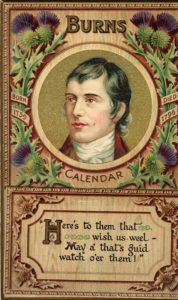
The collection was contained in a series of large boxes but has recently been sorted into accessible groups. There were in total 395 items, 282 in the main body and 113 in two display boxes, 103 items in one box, 10 in the other. The display boxes contain items that can be readily accessed for exhibitions.
The main body of items was sorted into the following groups:
- Burns` portraits, statues and monuments (29 items);
- The centenary of Burns` birth, 1859 (11 items);
- Burns` clubs, Burns` nights and highland gatherings (17 items);
- The centenary of Burns` death, 1896 (28 items);
- Burns` Festival on the River Doon, 1844 (5 items);
- Burns in context – biography, character and family (29 items);
- Burns` publishers, booksellers and collectors (26 items);
- Places associated with Burns (31 items);
- Burns` verses (many illustrated) and poems addressed to him (30 items);
- Burns` songs and other Scottish `sangs` and airs (23 items);
- Highland Mary (6 items);
- Old Edinburgh (6 items):
- Historical documents, not Burns (8);
- Miscellaneous (32 items).
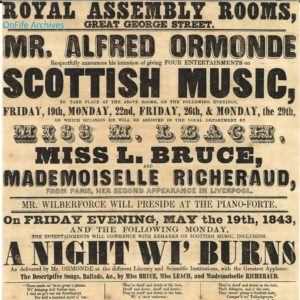
Display box 1 was sorted into:
- Portraits of Burns (43 items);
- Scottish entertainments featuring works by Burns (24 items);
- Poems, songs and music, including works by Burns (27 items);
- Portraits of associates of Burns (9 items).
Display box 2 contained just 10 items, including posters, calendars, songs and advertisements.
Some of the items in the collection may be unique and many are of considerable beauty and interest. Several of Burns` poems are well-known and frequently recited or sung but he wrote hundreds that are not so familiar. This collection includes many of them, mostly illustrated and often accompanied by their music.

And some of the places Burns had known are beautifully sketched – the Illustrated London News, January 29 1859 includes several of these.
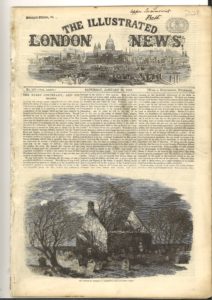
There are also some wonderful posters advertising Burns` concerts, especially those for the `Nicht wi` Burns` each January at the Royal Albert Hall, London, which include portraits of the Edwardian lady and gentlemen performers.
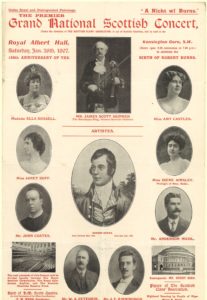
And, finally, the statues and portraits, of which there are many – some said to be good likenesses, some glamorised and one or two positively plain. Those showing Burns in ploughman mode or with his dogs are particularly appealing.
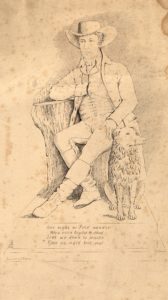
All in all, John Murison benefited posterity greatly in putting together his wonderful collection of memorabilia of Scotland`s famous bard, Robert Burns. Find out more about the Murison Burns collection and how it came to be in Dunfermline. Make an appointment to see the collection at Dunfermline Carnegie Library and Galleries

This blog from our inspiring volunteer, Jean Barclay, has been inspired by an article found in the wonderful resource called Anent of Dunfermline. The images are not from our own resources but reflect the story.
Part 1 – the Child-Stealing.
In May 1817, in the harsh times after the Napoleonic Wars, a young woman Janet Douglas of Gilmerton near Edinburgh, aged about 18, found herself out of work as a collier`s bearer. The job, which involved hauling hewn coal from the bottom of the shaft to the pithead, was heavy and degrading but at least brought in a wage however small. Janet, said to be sober and industrious, looked about for work but could find nothing in her locality. She was told, however, that there was work to be had at Halbeath Colliery across the Forth near Dunfermline and a woman told her that she stood more chance if she had a child with her as a potential pair of hands.
Janet decided to try Halbeath and on May 12th began her journey north. Reaching the Grassmarket area in the late morning, she noticed a little girl of about three in a light dress, a checked pinafore and a green bonnet and, giving her some sweets, persuaded the child to come with her. The little girl was Margaret or Maggie Reach, one of he three children of James Reach, a mason, at King`s Stables, Portsburgh, Edinburgh, and his wife, Marion Brown.
With Margaret in tow, Janet headed towards Queensferry, stopping now and then to ask for food and water for herself and `Jeannie`, as she called the little girl, and at Muttonhole (now Davidson`s Mains) a Miss Marshall gave her a penny to pay for the crossing. Passing Braehead near Cramond at about 3.30pm, they reached the ferry, crossed to North Queensferry and trudged on to Dunfermline and Halbeath. Here Janet quickly obtained employment and found lodgings with a miner James Barnard and his wife.
Meanwhile, Margaret`s distraught parents had began a desperate search. James went to the police watch-house in Portsburgh and to the police office in town and got the town crier to ring his bell to broadcast Maggie`s disappearance. The next morning, the 13th, he rose at four o`clock and walked to Whitehouse Toll and on to Leith, and then, after going home for a bite to eat, he took the road to Queensferry, by way of Craigleith Toll, Bell`s Mills, Muttonhole and Braehead, where several people, including Miss Marshall, told him they had seen the pair passing the day before. James decided to take the ferry and try Dunfermline as a likely place. In Dunfermline the weary man combed the streets and lodging houses and then spent the night in town. On the next day, the 14th, he had a stroke of luck as he met an observant weaver who told him that the day before he had noticed a stranger, a young woman travelling east carrying a child. By her appearance he had judged her to be a colliery woman and advised James to try Halbeath, two miles away. James proceeded there and after making enquiries found his little girl sitting by the fire in the Barnard`s house. Janet was out buying provisions and when she returned and saw James Reach with his delighted child, she pleaded with him to be lenient with her as she would have returned Maggie as soon as possible. However, after all his worry, James was adamant and, getting a lift to Dunfermline with a passing cadger, he obtained a warrant and returned with the town officer. The officer arrested Janet and took her to the town where she was questioned by the Provost and other members of the Council but denied any ill-intent. Having spent the night in Dunfermline prison, Janet was taken to the Old Tolbooth in the Canongate of Edinburgh. James Reach made his way home with his daughter on his back and showed her to some of the people who had seen her before and could identify her.

Part 2 – the Trial.
For four months Janet was imprisoned in Canongate Tolbooth awaiting her trial for child-stealing or plagium, a capital offence. The trial was finally held on September 8th 1817 at the High Court of Judiciary presided over by the Lord Justice Clerk, the Rt. Honourable David Boyle. For the Crown, James Wedderburn, Solicitor General, reminded the jury of enormity of the crime and the clearly established guilt of the prisoner as evidenced in witness statements from James Reach, who was in court, and from the people Janet and Maggie had met on their way (1). Mr. White for the defence observed that the child had been stolen, certainly in a culpable way, but from motives surely the least criminal that could possibly be conceived. He referred to her past good character (2), to her youth and inexperience and the fact that she had cared for the child with `all but a mother`s kindness` and intended to return her. After a summing up and without quitting the box for further discussion, the jury, who had a clear though painful duty to perform, found Janet guilty as charged. The Lord Justice Clerk addressed the prisoner about the enormity of her crime, put on his black cap and sentenced her to suffer the penalty of death in the city on Wednesday the 15th of October.
Janet hardly seemed to realise the awful doom fallen upon her but sat dazed and bewildered in the dock. More affected was James Reach, now full of pity for the unfortunate victim of her mistake and his pursuit, who burst into tears and was removed trembling from the Court.
Janet was now taken to the Old Tolbooth near St. Giles in the High Street, but not for long as it was soon to be demolished and replaced by a new prison on Calton Hill. Most prisoners were removed to the new prison but Janet and three men awaiting execution were sent to the lock-up house attached to the County Hall (3).
Janet`s case became a cause celebre and for a penny a broadside could be purchased penny entitled `Trial and Sentence! A True and Particular Account of the Trial and Sentence of Janet Douglas, who is to be executed on Wednesday the 15th Day of October next, for Child Stealing!!!` Janet`s case attracted considerable interest and sympathy in the town as many Edinburgh folk felt that she had been too harshly judged. Petitions for leniency led by her advocate Mr. White were signed all over the city. The Scotsman reported that several correspondents had written to them about the case and while reluctant to take it up, they had become convinced that `a considerable interest is felt in the fate of this poor woman, and that some mitigation of this awful sentence under which she now lies would gratify the feelings of the community`. The petitions were sent to London and bore fruit because early in October `the Magistrates of Edinburgh received a respite from the Prince Regent for Janet Douglas under sentence of death for child stealing until further signification of the Royal Highness`s pleasure` (4). Later in October the order was received that Janet was to be transported from Scotland for life, under contract for the first seven years.
Janet was sent to the new Calton Hill Prison to await her orders for transportation and on Tuesday, March 24th 1818, she was sent off from Edinburgh jail on her way to New South Wales along with fellow-prisoners Beatrix McLeod a forger and Isabella Maxwell who had been jailed for wilful fire-raising (5).

3. THE VOYAGE ON THE CONVICT SHIP MARIA:
Janet and her companions sailed south from Leith to Deptford, where they were probably kept in the prison hulks for a night or two. On Friday March 27th Janet was received on board the convict ship Maria, with her two companions from Scotland. The ship gradually filled with new arrivals until it contained 126 women convicts,
nearly 30 children, a free settler and his family in first class, and a full crew under Henry Williams the master. The surgeon was Thomas Prosser who was responsible not only for the clinical care of the women but for admitting and examining them, for attending to their welfare and for their meals and their quarters. Shortly before they left, Mr. Prosser employed a nurse named Young to assist him in the sick-bay.
At this time Elizabeth Fry was working to improve the lot of women prisoners and she came down to Deptford with a group of her friends to see what could be done for the convicts on the Maria and suggested many improvements for their comfort (6). She visited the prisoners almost daily and finally she saw them off with a short service on board, sailors from all the ships nearby crowding round their rails and up in the rigging to witness this unusual ceremony.
The Maria sailed from Deptford to Deal and then on May 15th began its four months voyage to New South Wales. Sadly, Janet Douglas was not among the 124 women and 25 children who disembarked at Port Jackson on September 17th, as she was been one of only two women (and a few babies) who had died during the voyage. Thanks to the surgeon, Thomas Prosser, we have a detailed account of what happened (7).
We first hear of Janet with a minor problem being treated by Prosser but on July the 18th she presented with severe pain in her side, back and belly after one of her room-mates had laid on her by accident. Janet was in pain for a few days, was badly bruised and developed a fever but gradually seemed to improve. However, not long afterwards she presented early in labour, having become pregnant at some point early during her imprisonment in Edinburgh (8). On Friday July 31st Prosser recorded that Janet, a small woman of 18, had began in labour at 4am. Labour progressed slowly through Saturday into Sunday when at 2pm Janet gave birth to a still-born son. Janet bled profusely and only spoke once when she asked the nurse of the sick-bay if the baby was alive and when told it was not said she would sooner have died than the child. Janet seemed to rally a little but the placenta was retained (perhaps due to the earlier accident) and she eventually bled to death. (8) The final sad note came on Monday August 3rd at 4pm when Thomas Prosser recorded that they had `committed the body of Jane Douglass and child to the deep`.
On arrival in New South Wales, some of the women stayed put, those with children were sent to work in Parramatta factory, some were employed as private servants, while 60 travelled on to Van Diemen`s Land, now Tasmania. Perhaps Janet, after serving out the seven years of her contract, could have built a reasonable life for herself as many did, but we will never know.
SOURCES AND NOTES:
Sources:
The main sources for Janet`s story are Daniel Thomson, `Anent Dunfermline`, Vol. 6, item 174, from Dunfermline Carnegie Library and Galleries (By error or design Thomson gives Janet`s surname as `Young`); and on line sources: Blackwood`s Magazine 1817, Vol. 2, pp. 109-10, and the broadside `Trial and Sentence!` mentioned above.
Notes:
1. The people that Janet met along the way were William Halliday of Craigleith toll, James Anderson of Bell`s Mills and his wife Helen Brotherton, Miss Marshall of Muttonhole, William Brown of Braehead and his wife Grace Macpherson and James Barnard and his wife Mary Brown of Halbeath.
2. Coal heavers at Gilmerton, John Robertson, William Brockie and William McKinlay, had stated that Janet worked industriously for her bread but had been obliged to leave Gilmerton for want of employment.
3. Janet`s fellow prisoners in the lock-up: Bernard and Hugh McIlvogue, and Patrick McCrystal, three Irishmen accused of robbery and rape, were executed in Greenock on October 10 1817.
4. The Scotsman, Sept. 20 1817; Morning Post, October 3 1817.
5. Inverness Journal and Northern Advertiser, April 3 1818. Elizabeth or Beatrix Wood, alias McLeod, nee Laing, and her husband James Seath or Wood, were both sentenced to seven years` transportation for forging a bill for £46; Isabella Maxwell, wilful fire-raiser, was sentenced to 14 years` transportation. What happened to Beatrix is unknown at present but Isabella was one of 60 women who went on from New South Wales to Van Diemen`s Land on the `Elizabeth Henrietta`.
6. Among Mrs. Fry`s suggestions, mostly implemented, were for the prisoners to be taken in closed carriages to the ship to avoid the stares and jeers that usually accompanied them; the division of the women into groups of 12 according to age and criminality, each under the charge of a steady convict; the provision of material and knitting wool from warehouses to help the women pass the time and to have something to sell on arrival, and for a schoolroom to be set up in the stern for the 14 of the 28 or so children and babies.
7. `Diary of the Maria Female Convict Ship commencing 7th March 1818 kept by Thomas Prosser Surgeon and Superintendent` (usefully transcribed and available on line). Prosser sometimes gives names for his female charges that are different from the original and Janet Douglas is known aboard as Jane Douglass.
8. Where and exactly when Janet became pregnant is a mystery but if the baby was full term it must have been about the end of October 1817, by which time Janet had been moved to Calton Hill.
9. Among the treatments Prosser used after Janet`s accident and then in his desperate efforts to save her life were: liniments, fomentations, laxatives, caudles (warm spiced drinks), antimony wine (antimony mixture in sweet wine), catheterisation, tincture of opium, spirits and volatile liquor of hartshorn (similar to smelling salts)
